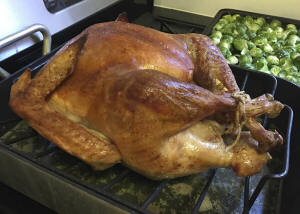Do not wash your turkey and other Thanksgiving tips to keep your food
safe
 Send a link to a friend
Send a link to a friend
 [November 26, 2024]
By JONEL ALECCIA [November 26, 2024]
By JONEL ALECCIA
Ready or not, the holidays are here. It's a time when many Americans
accustomed to preparing simple meals find themselves responsible for
safely serving multi-dish feasts.
It's no easy task. Outbreaks of some types of food poisoning tend to
rise in November and December, according to the U.S. Centers for Disease
Control and Prevention. Tainted turkey, undercooked stuffing and
germ-laced gravy from holiday buffets have all led to past illnesses —
and even deaths — CDC investigators have found.
It can be tricky for occasional cooks to prepare big meals in a way that
avoids the common hazards that can make people sick, said Donald
Schaffner, a food science expert at Rutgers University.
“Cooking takes longer with big masses of food. Cooling takes longer with
big masses of food,” said Schaffner, who co-hosts the food-safety
podcast “Risky or Not?”
Together with podcast co-host Benjamin Chapman, a food scientist at
North Carolina State University, Schaffner outlined common ways to keep
holiday meals both festive and safe.

Prepare the turkey
Nearly 90% of U.S. hosts plan to serve turkey on Thanksgiving this year,
according to the turkey producer Butterball.
But raw turkey can harbor illness-causing bacteria such as salmonella,
campylobacter and other germs. It must be handled safely to prevent
those bugs from contaminating refrigerator surfaces, sinks and kitchen
counters.
A frozen bird must be thawed first. There are several accepted methods,
including in the refrigerator, in the microwave or in cold running
water, Schaffner said.
“All of these methods pose risks,” he cautioned.
A frozen turkey needs about 24 hours for every 4 to 5 pounds of weight
to thaw in a refrigerator, according to the Agriculture Department. If
you use a microwave or the cold water method, the bird must be cooked
immediately. For details about safe turkey handling, check out the
thawing and cooking calculators created by the USDA.
And don’t wash the turkey. It’s a bad idea to rinse it in the sink, even
though many cooks still insist on the practice, often out of habit, said
Chapman.
“Anything that hits that surface and generates spray is going to
basically spread contamination around your kitchen,” he said.
Instead, pat the turkey dry with paper towels and toss them, or use a
kitchen towel and disinfect it in the laundry.
What about roasting?
Turkey needs to reach a cooked temperature of 165 degrees Fahrenheit
before serving. The best way to tell if it’s cooked is to use a
tip-sensitive digital thermometer inserted in the innermost section of
the thigh, not touching the bone.
[to top of second column]
|

Some of the food from a Thanksgiving dinner from Martha & Marley
Spoon in New York, Oct. 14, 2016. (AP Photo/Bree Fowler, File)
 Don’t rely on the plastic pop-up
thermometers stuck in some commercial turkeys. Chapman’s past
research shows that those buttons can activate well before the bird
is actually done.
At the same time, don’t determine doneness by relying on signs such
as golden-brown skin, whether the meat is no longer pink or whether
the juices run clear.
“None of those are great indicators of temperature,” Chapman said.
Side dishes and leftovers
How you handle the rest of the meal — mashed potatoes, gravy, green
beans or yams — is just as important as the main dish. It’s crucial
to avoid the so-called danger zone of temperatures between 40
degrees and 140 degrees Fahrenheit, where bacteria can easily grow.
The key is to keep hot foods piping hot and cold foods cold — and to
refrigerate everything promptly, Schaffner said.
“The recommendation is that you get those leftovers into the
refrigerator within two hours of when they came off of the stove,”
he said.
Make sure to refrigerate dense foods like sliced turkey, cooked
sweet potatoes or gravy in shallow containers to help them cool down
fast. Schaffner’s recent research showed that foods cooled in
containers at a depth of no more than 2 inches posed little risk of
growing dangerous germs.
Keep it clean
One key way to avoid food poisoning is through scrupulous cleaning
in the kitchen.

Wash your hands before preparing food and after touching raw
poultry. Use separate cutting boards, knives and other utensils when
handling raw meat and fresh foods such as vegetables and salads.
Pay close attention to any surface that may be contaminated. It’s
important to clean first with soap and water and then sanitize with
a disinfectant — a two-step process.
___
The Associated Press Health and Science Department receives support
from the Howard Hughes Medical Institute’s Science and Educational
Media Group. The AP is solely responsible for all content.
All contents © copyright 2024 Associated Press. All rights reserved |